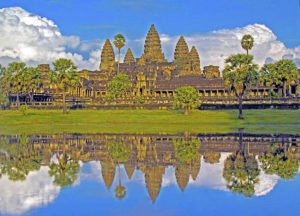
Angkor Wat Temple from the west gate. Photo by Dennis Cox/WorldViews
Contributing writer Robert Waite, who lately has chronicled his journeys from Albania to Namibia, Rwanda to Laos, didn’t know how well-timed his recent visit to Southeast Asia would prove to be.
Bob says that he and his wife, Karen, had purposely decided to travel to Laos and Cambodia in January of this year — “because January is somewhat cooler and a lot drier than, say, July. As it happened, that was just as COVID-19 was beginning to wend its way out of Wuhan.”
And so, just in time, Bob finally made it to Angkor Wat, one of the top destinations on his life list and the featured topic of Part I of his two-part series about the memorable sights and activities in the area around Siem Reap, Cambodia. Here are Bob’s reflections on visiting one of the world’s great archaeological wonders:
By Robert Waite
Siem Reap, Cambodia —
In travel, as in virtually everything else in life, expectation is part of the experience. However, the greater the expectation, the more likely you’ll succumb to its mirror-image opposite, disappointment.
I learned this lesson early with my first visit to the Empire State Building. Absent King Kong and Faye Ray, it just struck me as a tall slab. The nearby Chrysler Building, on the other hand, turned out to be a surprise and a delight.
I expect we’ve all had similar travel disappointments.
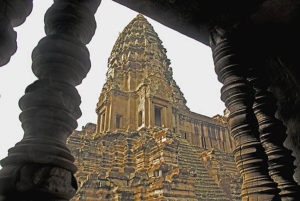
Angkor Wat tower from inside temple ruins. Photo by Dennis Cox/WorldViews
It was in this frame of mind that I approached Angkor Wat, Cambodia’s famed UNESCO World Heritage site.
We were coming from Laos, a country which had exceeded expectations. Landing in Siem Reap, I worried that a let-down might inevitably follow. Angkor Wat had been at the top of my travel destination list for decades, spurred by articles and photographs in magazines like National Geographic and Life.
At times, however – due to periods of civil unrest and war – this goal seemed unattainable. Indeed, at one point western media reported that the huge complex, then being used as a kind of antiquities shield by rebels, was on the verge of destruction.
The good news is that while the threat was real, the extent of the reported damage was exaggerated.
The better news is that Angkor Wat and its neighboring sites more than meet expectations.
Beating the Crowds
Upon arrival we were met by our guide, Mr. Narin. As it was evening, we were taken to our accommodations, the Treeline Urban Resort, an architecturally interesting hotel located in the Wat Bo district on the Siem Reap River.
Mr. Narin briefed us on what to expect the next day – many things to see and much walking. Ample water and good footwear would be a must, he advised.
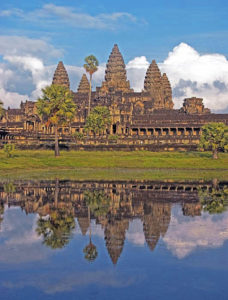
Angkor Wat’s towers reflected in the moat. Photo by Dennis Cox/WorldViews
The next morning our tour began with Angkor Wat, the most famous of the temples located on a plain just a three-mile (five-km) drive north from our hotel.
Often tour guides will first take you to other nearby temples, like Angkor Thom or the Bayon Temple, saving Wat as a kind of grand finale.
But Mr. Narin’s strategy was to get to the most famous site early to avoid the inevitable crowds and lines. It proved to be a smart move.
Prior to entering the site itself you go to a large tourist pavilion, accessed from a U-shaped road. There is a confusing array of wickets and a great many people milling about.
Having a guide to sort this out saves time – and in the moments you do have to wait, there is an interesting photo exhibit chronicling the ongoing international effort, led by Japan, China and Germany, to restore and maintain the structures.
Entering Angkor Wat
Angkor Wat was built in the first half of the 12th century as a Hindu Temple dedicated to the god Vishnu. It is said to depict in miniature the Hindu conception of the universe in stone.
This Hindu use did not last very long, as a succeeding dynasty favored Buddhism, but the classical Indian-inspired architecture and decoration was largely left in place.
The scale of the complex becomes apparent as you approach – it sits on 402 acres and is surrounded by a huge moat 650 feet (200 meters) wide; 13 feet (four meters) deep; and a length, at its perimeter, of three miles (five km).
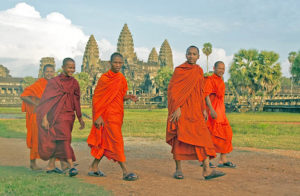
Young monks at ruins of Angkor Wat. Photo by Dennis Cox/WorldViews
As you walk across an access causeway the towers look like the kind of drip-sandcastles you might have created at a beach as a kid. The difference, of course, is that those were washed away by the next incoming tide; these have stood for almost 900 years.
What a Relief — or Not?
One of the most interesting aspects of the temple is the bas-reliefs, which depict various Hindu narratives. Located on walls protected by porticos, they have some protection from the elements and have survived – or, in some cases, have been restored.
One series, according to our guide, depicts three tiers of the afterlife. At the top is a version of heaven or Nirvana; in the middle is something like a purgatory or waiting room, with people striving to move upwards; at the bottom is a version of hell – think of the most hideous Hieronymus Bosch painting, done in bas-relief.
I have to be honest here. I was raised Roman Catholic, with all of the attendant fears of eternal damnation. When visiting the Sistine Chapel, some of Michelangelo’s ceiling scenes made me nervous.
And I was never a big fan of Dante’s Inferno, which, for reasons that escape me to this day, was required reading for one of my classes at the boarding school of my youth.
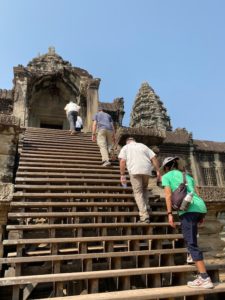
Climbing the Stairway to Heaven. Photo by Robert Waite.
My spouse, on the other hand, was raised in the Buddhist tradition and is convinced the afterlife will have her returning as a butterfly or a yellow lab. She gets no end of pleasure torturing me about my afterlife fears. She now takes great joy telling me, when I transgress, that I surely will be heading to the bottom level (or lower). No stairway to heaven for me.
Dramatic Vistas
One of the highlights at Angkor Wat is the view from the center tower, which can be reached on moderately steep exterior wooden stairs. This is where coming early paid off – the line-up was not terribly long.
Given that you must stand in an open courtyard under a beating sun, doing so for even 10-15 minutes is taxing. Having plenty of water (and, if you are follicle-challenged like me, a good hat) is a must.
The views from the top of the tower are worth the effort.
It is only from above that you get a full sense of the scale of the complex and understand why it’s compared to Beijing’s massive Forbidden City and is regarded as the largest religious archaeological site in the world.
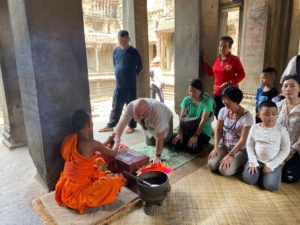
The monks’ ceremonial water blessing. Photo by Robert Waite
Back down from the tower stairs, we make our way to a sheltered alcove where we find a Buddhist monk dispensing “Srouch Teok” or a Water Blessing, for the lunar New Year. The monk chants in ancient Pali and splashes water on you to wash away your sins and bad luck.
This seems a particularly good idea in light of the scenes of damnation I had witnessed just two hours before –so I went for it.
At the end of the ceremony the monk ties a red cord around your right wrist. With the advent of COVID-19, I decided to keep it on and I’m still wearing it to this day; my spousal unit long ago cast hers aside. Apparently, butterflies don’t need good luck charms,
If You Go
Siem Reap can be reached from Ho Chi Minh City (Saigon), Hanoi, or Luang Prabang, Laos, on Vietnam Airlines; from Bangkok on Thai Airlines; and from Singapore on Singapore Airlines. We stayed at the Treeline Urban Resort, a stylish Five Star Hotel centrally located in Siem Reap’s best district, Siem Bo. A number of good restaurants are within walking distance. Travel arrangements were made through JBC Travel, Ottawa, Canada.
A Preview of Part II:
A visit to Angkor Thom, including the South Gate, the Bayon Temple, unique for its 54 towers decorated with over 200 smiling faces; a visit to Chreav Communities Village in the countryside, including an oxcart tour; and a boat ride on Tonle Sap, Southeast Asia’s largest freshwater lake (to visit so-called “floating villages” and a town that contends with 20-30 foot differences in water level, depending on the season).
Author Bio: Robert Waite has written on travel for almost 50 years. A former Pacific News Service correspondent, he is a professor at Seneca College in Toronto and Managing Partner at Waite + Co., a communications consulting firm with offices in Boston, Ottawa and Toronto.












2 Responses to Angkor Wat’s Stairway to Heaven